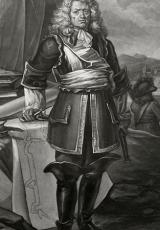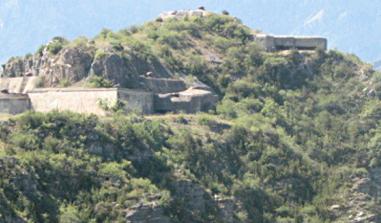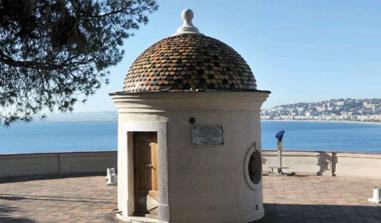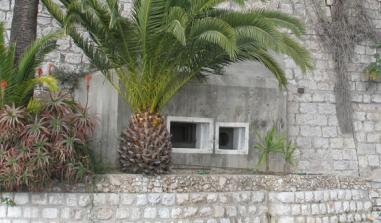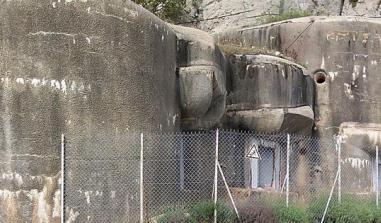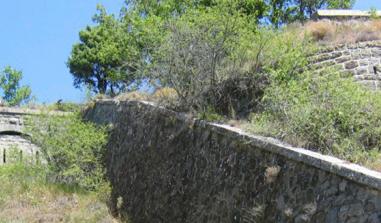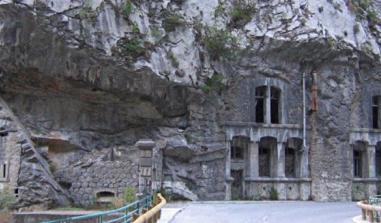The Royal Fort Royal of the island of Sainte-Marguerite
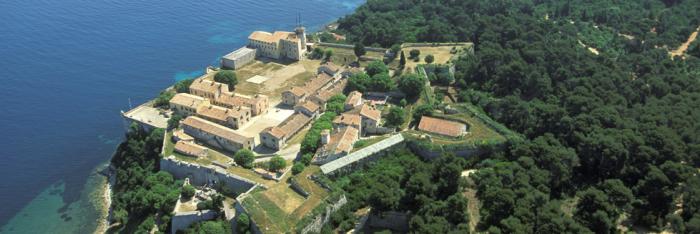
The Royal fort on the island of Sainte-Marguerite. Source: ECPAD
Situated in the Bay of Cannes, the royal fort, a state prison, played host to the Iron Mask from 1687 to 1688 and then, after the war, to Marshall Bazaine.
To the south east of la Croisette, the archipelago of the Lérins islands separates the Gulf of Napoule to the west from the Gulf of Jouan to the east. It comprises four islands: two large ones (Sainte-Marguerite and Saint-Honorat) and two small ones (the islet of la Tradelière and the islet of Saint-Féréol). The island of Sainte-Marguerite is the closest to Cannes, just 700 metres from the Palm-Beach headland, and the most extensive, covering more than 160 hectares. The island takes its name from a chapel built there in honour of the martyr of Antioche during the first centuries of Christianity. After the occupation of the island by the Romans, whose traces still remain today, for many centuries Sainte-Marguerite belonged to the monks of Lérins. In 1617, the Duke de Guise gave Jean de Bellon the task of building a fort intended to block access to Cannes. Constructed between 1624 and 1627 on the site of remains dating back to Roman antiquity, at the time it was nothing more than a simple fortified house.
This small fortification was enlarged and strengthened by the Spanish who occupied the islands of Lérins from 1635. Two bastions and the first barrack buildings were added to the existing construction. With a garrison of approximately 800 men on the island of Sainte-Marguerite, the Spanish troops were faced with the vital question of supplying drinking water and invented a system for collecting rainwater, which fed into a large well built upon enormous tanks. Today you can still see the four decantation basins where the water was purified before filling one of the two tanks set under the well. In 1637, the French took back the Islands of Lérins, and named the citadel the Royal fort. The fortification was then considerably strengthened: the moats were made deeper, the curtain wall was raised and two demi-lunes were then linked to the fort by elevated walkways, which have since disappeared. The royal governor, Guitaut, also had a "tenaille" built, a low bastion placed in front of the entrance gates to the fort, which bears his name today.
At the end of the 17th Century, Louis XIV's general commissioner of fortifications personally inspected the fort, and gave instructions to strengthen the square. Work carried out as a result of Vauban's visit give the fort most of the appearance that we still recognise today. 26 metres above sea level, the structure projects over a rocky cliff on the northern coast of the Island of Sainte-Marguerite, opposite cape Croisette. It is a small fort that is pentagonal in shape, flanked by four bastions at its weak points, on the land side. On the coastal side, the structure's stone ramparts are supported by an earth embankment and blend remarkably into the sheer cliff. Inside the compound, a chapel, and several barns used to house the troops and the artillery stores still survive today. Amongst the latter, we can see the impressive building that constituted the powder store, surrounded by the walls of the royal bastion to the south of the fort, probably intended to reduce the consequences of any accidental explosion. After this, the structure was the subject of minor alterations. And so, in 1862, a semaphore was constructed by raising one of the fort's old towers. Later, during the occupation by German troops during the Second World War, a surveillance station was established on one of the fort's triangular promontories Today, several buildings are in ruins and the invading vegetation is gradually taking over the demi-lunes and the ramparts. However, teams of young workers from Provence-Alpes-Côte-d'Azur have been helping to renovate the fort for more than thirty years. The ramparts have been made safe and building repairs and much restoration work have been carried out so as to make visits possible to this fortification, which is unique along the Cannes coastline.
From 1637 onwards the first cells were fitted out in the governor's château. But it was in 1685, at a time when the Royal fort accommodated a large garrison, that the fort was dedicated definitively and first and foremost to be used as a state prison. So, in 1687, Governor Saint-Mars, on the orders of Louis XIV, had a parallelepiped stone building constructed inside the compound, inside which several cells were soon fitted out. The prisoners held inside the fort include most notably: [list]the famous, but nevertheless unidentified, Iron Mask, held for 11 years from 1687 to 1698; [list]Six protestant pastors, imprisoned following the revocation of the Edict of Nantes, from 1689 until their death in 1713; [list]Jean-Baptiste Suard, who would become the eternal secretary of the French Academy, incarcerated between 1751 and 1753; [list]The Smala d'Abd el-Kader, from 1843; [list]600 Austrian prisoners, detained in 1859 after the battle of Montebello; [list]Marshall Bazaine, the only prisoner to have escaped from the Royal fort in 1873, in what legend describes as a fantastic escape and after whom a terrace of the fort is today named. The Royal fort also has a smaller detention area, reserved for soldiers. The Museum of the Sea, located inside the fort, allows visitors to look at some of the cells, including that of the Iron Mask, as well as those occupied by the protestant pastors, to whom there is now a memorial.
On the Island of Sainte-Marguerite Although the Museum of the Sea allows visits to the inside of the Royal fort compound and its dark cells, it also has a second museographic area, which houses an important collection of submarine and land archaeology. In the heart of the old roman reservoirs and recently restored chambers, the museum exhibits the wrecks of boats that ran aground off the shores of the Islands of Lérins. Visitors can also see a model reconstruction of the roman water reservoir system, a collection of painted designs dating back to antiquity and a room housing aquariums presented by the permanent centre of initiatives for the environment, which display the underwater flora and fauna of the Mediterranean. Inside the fort, an entertainment and accommodation centre has been established which is able offer different types of holidays to a varied clientele: introductory classes and training courses for sport or cultural activities for schools, playing host to business associations or committees, organising seminars etc. Lastly, the island of Sainte-Marguerite is able to welcome around half a million visitors per year because it can also offer an extraordinary natural heritage. The island is criss-crossed by forest paths and a coastal path that allows a circuit of the island close to the clear seabed. A well-marked botanical trail allows visitors to spot the many kinds of maritime plants and trees. To the west of the island, the Batéguiers lake offers shelter to the many migrating birds that can be observed throughout the year. Its 150 hectares of pine and eucalyptus forests make the island of Sainte-Marguerite a unique setting for quiet walks along the coastline of the Alpes-Maritimes. The national forestry office is responsible for the protection of the island's remarkable forest plantations, welcoming the public by offering activities as an introduction to this rich natural environment. On the island of Saint-Honorat The island of Saint-Honorat has several chapels, constructed very early on to welcome pilgrims. Although today one of them is in ruins, the six others were restored in the 17th century and more recently with the aid of the original plans. At one end of the island there is a cannonball oven, employed by the artillery of the First Empire to heat the projectiles used to set fire to the wooden boats that threatened the coasts. The island is also home to the abbey of Lérins, which houses a community of about thirty monks of various nationalities, who cultivate lavender and work the vines. A jewel of the feudal architecture of the Provence area, the fortified monastery was constructed between the 11th and 14th centuries and is open to the public. The abbey produces a liqueur made from around thirty aromatic plants, whose recipe remains secret and which must be consumed in moderation.
Cannes Tourist Information Office Esplanade Georges Pompidou BP 272 06403 Cannes Cedex Tel. + 33 (0) 4.92.99.84.22 Fax + 33 (0) 4.92.99.84.23 e-mail: tourisme@semec.com The Museum of the Sea Open every day, except Monday and some Bank Holidays. Closed annually in November. The museum is free on the first Sunday of every month and on a permanent basis for the under 18's and students under 26 years of age. Free guided tours can be arranged by appointment. Museum of the Sea Parking Pantiero Fort de l'île Sainte-Marguerite Tel. + 33 (0) 4.93.38.55.26 Access by sea from Cannes. Several maritime transport companies operate along the islands' quays, at the end of the Laubeuf car park. Services to the Islands of Lérins operate all year round (allow around twenty minutes to cross to the Island of Sainte-Marguerite).
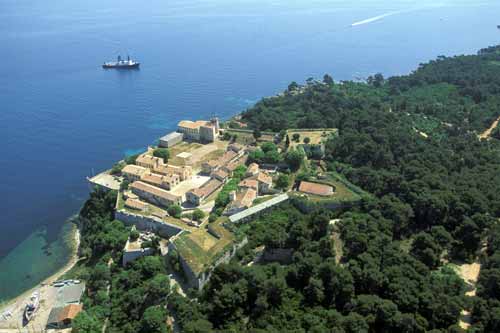
The Royal fort on the island of Sainte-Marguerite. Source: ECPAD
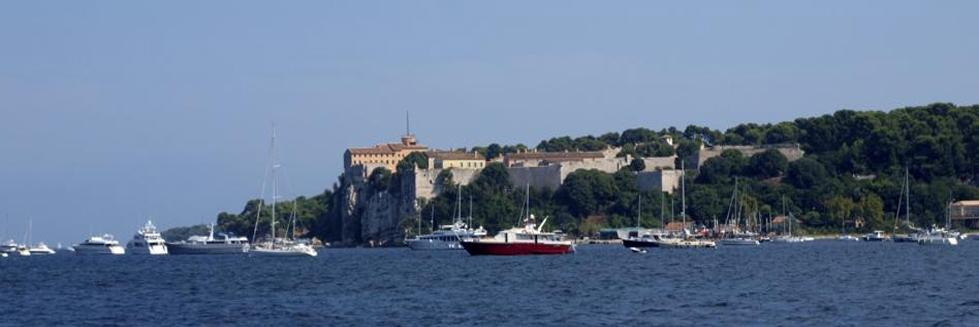
Le fort vu de la rade de Cannes. Source : Qypchak. Licence Creative Commons. Libre de droit
Practical information
6150
Cannes
04 93 38 55 26
Plein tarif: 6 € Tarif réduit: 3 € Gratuit : Gratuit le 1er dimanche de chaque mois de novembre à mars inclus, moins de 18 ans, et étudiants jusqu’à 26 ans.
De octobre à mars: 10h30-13h15 / 14h15-16h45 De avril à mai: 10h30-13h15 / 14h15-17h45 De juin à septembre: 10h-17h45
Fermé tous les lundis de octobre à mars, le 1er janvier, le 1er mai, les 1er et 11 novembre et le 25 décembre



